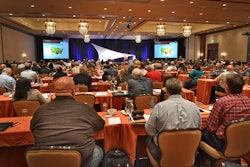 Annette Sandberg, principal of TranSafe Consulting, speaks that CCJ Fall Symposium
Annette Sandberg, principal of TranSafe Consulting, speaks that CCJ Fall Symposium“Driving a large truck typically requires all of your senses,” stated Annette Sandberg, a fleet safety and compliance expert at the CCJ Fall Symposium in Scottsdale, Ariz., on Nov. 7. During the past two years, she noted how the Federal Motor Carrier Safety Administration has been giving hearing-impaired drivers an exemption from the medical standards of a commercial driver’s license.
“People who have never driven a truck before, who cannot hear at all, now are being given CDLs,” said Sandberg, principal of TranSafe Consulting and former FMCSA administrator from 2003 to 2008. The agency, she said, has “very little scientific evidence in the docket” for waiving some of its medical standards.
Recently, the agency granted waivers to about 40 drivers who are missing one of their eyes. It also has been getting requests, mainly by special interest groups, to grant waivers to epileptic drivers.
“There is a huge erosion in the medical standards,” she said.
As a result of these decisions by the FMCSA, carriers have become the responsible party for deciding whether or not drivers are medically fit for duty. Refusing to hire a driver with a hearing, sight or neurological disorder could open the door to a lawsuit from the Equal Employment Opportunity Commission (EEOC) for violating the American with Disabilities Act (ADA), she said.
Medical exemptions were among many regulations she discussed at the event. Here is a summary of her remarks on pending rules from FMCSA as well as current studies and activities that may become new regulations.
Pending rules
- Drug and Alcohol Clearinghouse is expected to become final in September, 2015. The trucking industry requested this rule to prevent hiring drivers who have previously tested positive for substance abuse and not completed a recovery program.
- Minimum Insurance Increase has entered the advanced notice of proposed rulemaking (ANPRM) stage after clearing the White House’s Office of Management and Budget. Originally, the rule sought to increase motor carriers’ minimum liability coverage from $750,000 to $2 million. The increase in premiums could potentially put many small carriers out of business.
Starting this week, the industry will be able to comment on what the minimum level of insurance should be based on their average settlements from crashes, she said.
- Speed Limiters is another rule requested by the industry. It is in the ANPRM stage scheduled for release and comment in January, 2015. The FMCSA will likely propose a range of speed settings for heavy-duty vehicles. The final rule should be ready in late 2015 and implementation slated for 2017.
- Electronic Logging Devices and Hours of Service Supporting Documents is the long-awaited rule, or mandate, for ELDs. A final rule is scheduled for September 2015. After a two-year implementation period, enforcement would begin in late 2017.
- Entry level driver training was included in the last highway re-authorization bill. FMCSA was supposed to create a rule by October 2013, but the agency does not yet have a proposed rule.
“It is hard for the agency to figure out what the cost benefit is going to be,” she said. The FMCSA is currently taking comments from drivers and holding listening sessions but a final rule is still “a long way out.”
- Prohibition of coercion was published in May, 2014. The comment period is closed awaiting a final rule to be published after January, 2015. This rule will impact carriers, shippers, brokers and anybody else that coerces drivers to violate hours-of-service rules. “This is going to have a big impact on others outside the industry who normally haven’t thought that they had much control over the driver and any responsibility for what they did,” she said. Violators will be investigated by the Occupational Safety and Heath Administration (OSHA).
- Safety fitness determination is scheduled for release in March, 2015. This is a major revision of the way FMCSA rates trucking companies. Sandberg said the rule is “problematic.”
- Commercial learners permit and CDL requirements, effective next year, will tighten down the CDL requirements. Drivers will no longer be able to obtain a CDL from one state and then transfer it to their permanent state of residence.
- Medical examiners certification integration clears the way for medical examiners to automatically send the results of a DOT exam to the Department of Motor Vehicles. “It saves a step but the problem is a lot of states are not ready for this. I think it will be delayed,” she said.
- Patterns of safety violations, published in early 2014, will penalize all transportation companies that operate under a single corporate umbrella if the FMCSA finds a pattern of safety violations for one of the companies.
Proposed rules:
- Insulin dependent drivers. This rule, expected to be issued next year, will allow drivers who meet certain standards to pass a medical exam without needing to get an exemption.
- Sleep apnea. The agency is working on issuing a rule to supersede the guidance it has issued to medical examiners for drivers who need to be tested for sleep apnea.
Studies and other activities:
- HOS restart provision study. A proposal is now attached to a bill in the Senate that would revert back to the old 34-hour restart provision in the hours of service rules until a study is completed. The current 34-hour restart can only be used once every 168 hours and requires two consecutive periods off between 1-5 AM.
Sandberg doubts that Congress will pass anything in a lame duck session.
- Elimination of self-insurance. The agency has recommended to eliminate self-insurance for motor carriers mainly because of the time it takes the agency to administer these programs.










